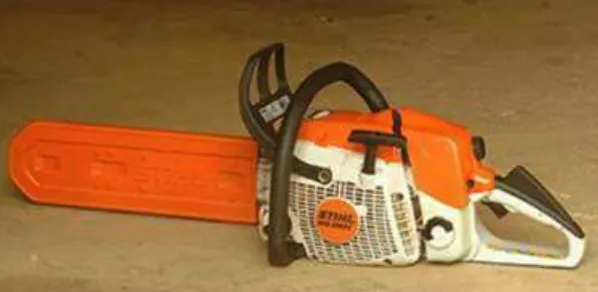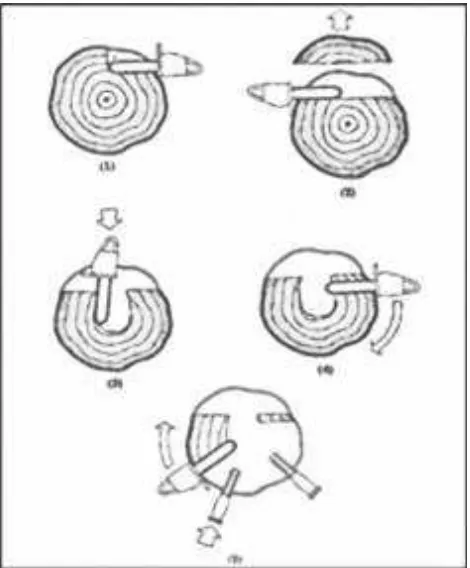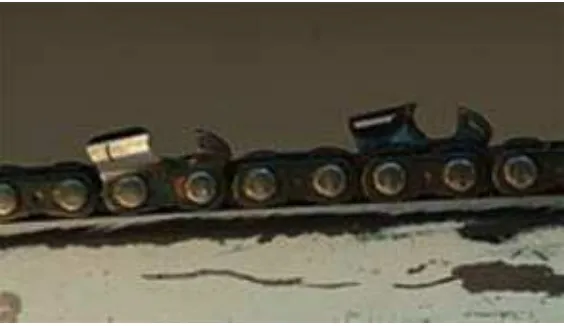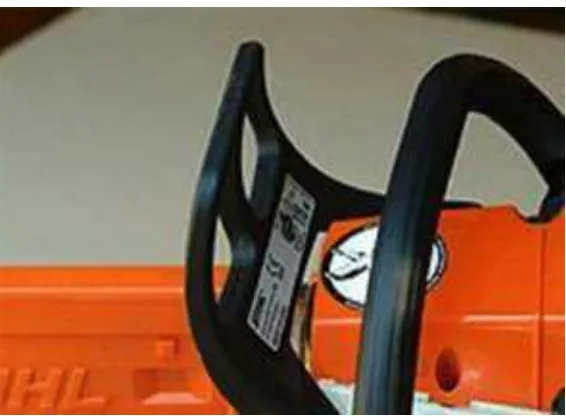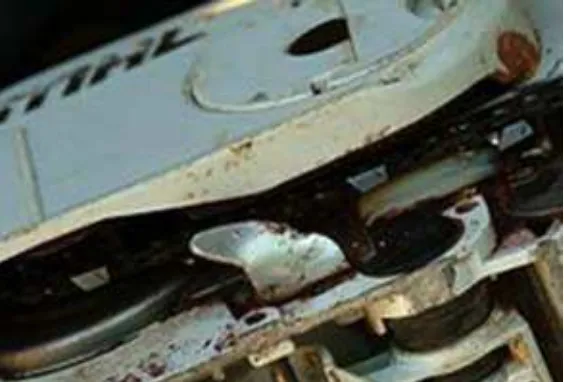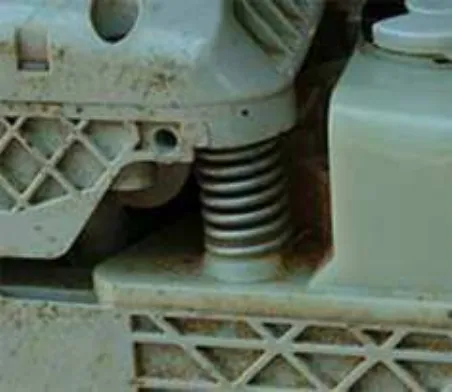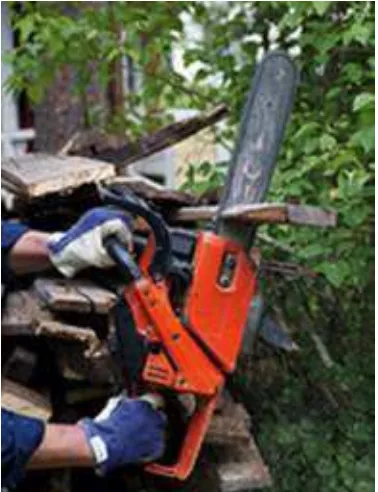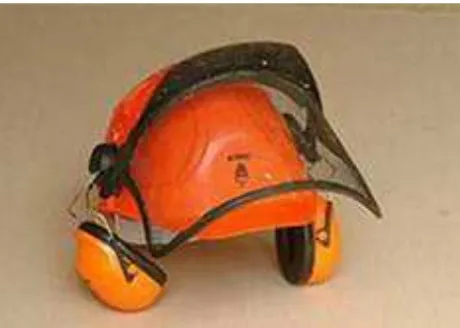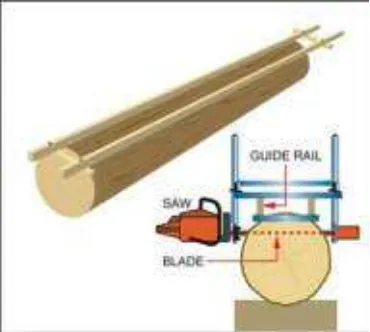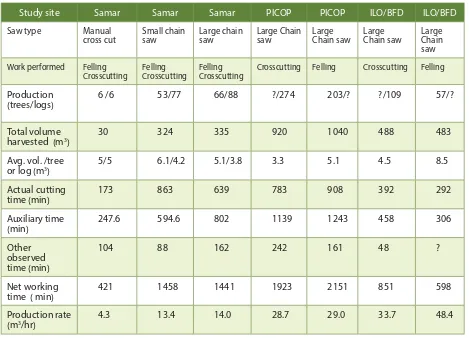2
Chainsaws
RECOFTC - The Center for People and Forests Copyright © RECOFTC December 2015 Bangkok, Thailand
All photos courtesy of RECOFTC except where reference is indicated
Reproduction of this publication for educational or other non-commercial purposes is authorized without prior written permission from the copyright holders provided the source is fully acknowledged. Reproduction of this publication for resale or other commercial purposes is prohibited without written permission of the copyright holder.
This publication has been generously funded by the Ministry for Foreign Afairs of Finland. The views expressed in this publication are those of the authors and do not necessarily relect the views of RECOFTC and our donor organizations.
Table of contents
1. Introduction
1
2. Safety aspects
3
3. Chains
5
4. Chain brake
7
5. Chain catcher
9
6. Safety throttle
9
7. Centrifugal clutch
10
8. Canti-vibration system
10
9. Handles
11
10. Protective clothing
13
10.1 Helmet 13
10.2 Visor or goggles 13
10.3 Chainsaw safety mitt 13
10.4 Trousers 14
10.5 Gloves 14
10.6 Boots 14
10.7 First aid kit 14
11. Chainsaw milling
15
12. Performance studies
17
Figures
Figure 1. Chainsaw with protective scabbard over the bar and chain 1 Figure 2. Physical strain expressed by pulse rate changes in handling large- and small-sized
chainsaws during felling operations in Mexican pine plantations (Villagómez, MA 2011) 1 Figure 3. Cutting around larger trees with small chainsaws and short guide bars 2 Figure 4. Chain on guide bar 6 Figure 5. Front hand guard and a chain brake lever 7
Figure 6. Chain catcher 9
Figure 7. Safety throttle 9 Figure 8. Centrifugal clutch 10 Figure 9. Metal spring anti-vibration system. 10 Figure 10. Rear-handled chainsaw used with a two-handed grip 11 Figure 11. Top-handled chainsaws 11 Figure 12. Safety helmet with visor and ear defenders 13 Figure 13. Chainsaw milling with guide bar and rail 11 Figure 14. Machine costs and labor requirement for harvest volume of 100 m3 with diferent
saw types in natural forests (from Laarman 1981) 18 Figure 15. Machine costs and labor requirement for diferent saw types in thinning 100 stems
of plantation (Laarman 1981) 18
Tables
Table 1. Production costs market prices of lumber and proitability of chainsaw milling (ETFRN 2010) 15 Table 2. Comparative studies of handsaws, small and large chain saws in felling and crosscutting
1. Introduction
The introduction and safe use of chainsaws is arguably the biggest improvement in small-scale forestry harvesting. Felling timber with chainsaws can be accomplished over a relatively short period of time while requiring only a small investment – that is, if laws allow the use of this type of machinery and if service providers for training, maintenance and supply of spare parts, as well as additional support, is in place.
There has been steady development in chainsaw performance and design over the past few decades. The overall trend has been towards safety and comfort in use, which has translated to good machine balance, low weight, low noise level, low vibration level, chain brakes and right hand safety triggers. Chainsaws are now available in many makes and models that are matched for speciic applications.
Figure 1. Chainsaw with protective scabbard over the bar and chain
Although there has been much improvement in the chainsaw over the past few decades, the safe and lightweight chainsaw has yet to be adopted in community and smallholder settings. Heavy gear-driven saws weighing 15 kilograms (kg) or more, frequently without any of the modern safety or anti-vibration devices, are still in use in such locations. The larger saw is said to be preferred because of its reliability, ability to withstand
harsh treatment and because it delivers the power needed to cut through large-diameter trees and logs. Often, however, communities and smallholders are only cutting smaller logs and the use of large saws entails hidden ergonomic costs borne by the workers, such as heavy carrying weight, high risk of work-related accidents and hearing impairment.
Figure 2. Physical strain expressed by pulse rate changes in handling large- and small-sized chainsaws during felling operations in Mexican pine plantations (Villagómez, MA 2011)
140
(Mc Culloch 850) DIA 1”
Day time (hrs) Hl Hl
2
That a smaller, modern chainsaw of reduced power and weight could not be used under average forest conditions has never been substantiated by research or demonstration in the Mekong region. However, this needs further studies to demonstrate that small chainsaws are suitable for trees of 75-100 centimeters (cm) in diameter (or sometimes even larger) if the trees have buttresses. Using the technique of cutting "around" rather than "through" the tree (Figure 3), it is possible to fell trees that have cutting diameters of about 2.5 times larger than the normal guide bars used.
2. Safety aspects
Modern chainsaws incorporate numerous safety features common to many engine-driven power tools. Manufacturers have invented numerous design standards and many of these are legal requirements in certain areas. Best practice dictates that an operator should inspect the saw before starting work and only operate the saw if all the safety features are functioning properly.
Most chainsaw safety features are focused on the so called kickback problem and seek to either avoid it through a chain and bar design, or to reduce the risk of injury should it occur through chain brakes. Chainsaw kickback can occur when the tip of the bar comes into contact with a relatively massive or immovable object while the chain is under power. The area of the bar tip most likely to be involved is known as the "kickback quarter." Looking from the side of the bar, the kickback quarter is the 90° section of bar found between a line going along the center line of the bar and another line at 90° to the irst, rising upwards from the center of the nose sprocket. If this area of chain comes into contact with, for instance, a log, the chain will initially cut the wood but will also produce a reaction force that pushes the bar upwards. As the bar rises, the chain is forced harder into contact with the wood and climbs upwards even harder. In a fraction of a second, the chain may jam hard into the wood and hurl the bar upward towards the operator, often causing severe injury or even in some cases, death. The violence of a full kickback event is such that no evasive action is possible. If the operator's head, neck or shoulders are in-line with the plane of the bar, the operator will certainly be struck by it. At this point, the operator must rely on the chain brake and protective clothing to avoid injury.
Another form of kickback may occur when the top of the bar is used for cutting and suddenly becomes pinched by wood movement. In this case, the saw may be forced backwards towards the operator or forced into a position where the tip is pinched and the saw transitions into a tip-driven kickback. Kickback may also occur as a result of a failed or improperly executed boring cut. Bore cutting is a specialized technique, which should not be attempted without the proper training.
By far the most efective tool in preventing kickback is operator training. Kickback may be avoided by preventing contact between the bar tip and solid objects. Injury may be prevented if operators keep their heads and bodies out of the cutting plane of the bar. A useful tip is that if the operator cannot read the logo on the side of the bar, then the operator is too close to the cutting plane and should lean left to ensure safety.
Correct chain sharpening is paramount to safety in this context. Blunt chains cut poorly and lead to increased operator fatigue and bar loading. Depth gauges iled too low can make the chain grab at the wood and may negate the beneits ofered by the safety chain.
4
3. Chains
The chain has to be properly matched to the guide bar and the saw. Chainsaw manufacturers specify a selection of suitable chains for each model of saw. Good safety practice requires that the chain be properly sharpened. One key sharpening parameter is the depth gauge setting. The depth gauge is the small steel protuberance in front of each cutting tooth. The diference in height between the leading cutting edge and the depth gauge determines the thickness of the wood chip taken by the cutter. If the depth gauge is too low, the cutter takes too deep a bite from the wood, the saw becomes diicult to control and the chance of kickback increases. Some chains also have guard links in front of each cutter link. The guard link reduces the tendency of the leading edge of the depth gauge to snag on small-diameter objects such as small branches or to engage with ordinary timber if forced into contact with it. There are various arrangements of teeth on the chain:
§
§
"Full complement" chain has a left cutter, drive link - right cutter, drive link arrangement and is used for most applications.§
§
"Skip" has a left cutter, drive link - drive link, right cutter arrangement. It has one-third fewer cutting teeth and is generally used on long bars (24 inches and longer) for added chip clearance or when a bar longer than the ideal for a given power head is used. Fewer teeth require less power to operate.§
§
"Semi-skip" alternates between having one or two drive links between pairs of cutters, which results in a performance that is in-between that of “full complement” and “skip” arrangements.§
§
Three basic conigurations exist for general use in forestry, tree surgery and irewood cutting. Full chisel chain has a square-cornered tooth, splitting wood ibers easily in the cut for fast, eicient cutting of clean softwood. Semi-chisel chain has a rounded working corner formed by a radius between the top and side plates. While slower than full chisel in softwood, it retains an acceptable cutting sharpness longer, making it the preferred choice for dirtier wood, hard or dry wood, frozen wood or stump work, all of which would rapidly degrade a full chisel chain. "Chamfer chisel" chains by the company Oregon are similar to the semi-chisel design but have a small 45-degree chamfer between the plates rather than a radius. Performance is similar to a good semi-chisel.§
§
The key diference between semi-chisel and chipper chains is the size of the radius at the working corner. In its cross-section, a chipper tooth looks like a question mark – with a full radius over the whole cutting portion of the tooth – whereas a semi-chisel design looks more like the number "7" with a slightly rounded top-right corner.6
Cutting chain comes in a large number of conigurations but these are reduced to a few key dimensions for replacement or speciication purposes.
§
§
The gauge of the chain is the thickness of the drive links and is dictated by the gauge of the bar on which it is to be run. Usual gauges are .050 (1.3) - .058 inches (1.5 mm) and .063 inches (1.6 mm). Chain and bar gauges must match: a chain that is too large will not it and one that is too small will fall sideways and cut poorly.§
§
The pitch of the chain is the average distance between two rivets. Since the distance between rivets varies, measuring between three rivets and dividing this distance by two can determine the pitch. Usual pitches are 0.325, 0.375 and 0.404 inches. The pitch size 0.75 inches is used for harvester applications and very rarely for handheld cutting. The pitch of the chain must match the drive sprocket and the nose sprocket (if itted).§
§
A chain loop must be of an appropriate length in order to run safely, itting the number of drive links, which is determined by the length and type of bar, the sprocket size and the overall coniguration of the saw. For replacement purposes, simply count the drive links on the old chain.4. Chain brake
Chain brakes prevent movement of the saw's cutting chain by applying a steel brake band around the driven clutch drum. Clamping force for the brake band is provided by a powerful spring. The chain brake has two purposes. First, it can be used to secure the chain when changing positions, moving between cuts or starting a cold saw, which requires a partly open throttle and would otherwise lead to uncontrolled chain movement, a major hazard in older saws. Second, the chain brake can activate under kickback conditions to prevent the operator from being struck by a running chain. Being struck by even a static chain may cause serious injury and anything that can be done to mitigate such injuries caused by contact with a moving chain is of considerable beneit to operators. Kickback injuries usually occur to the head, face, neck and shoulders. When a running chain is involved, such injuries are usually very serious, often disiguring and sometimes fatal.
To operate the chain brake, the chainsaw operater pushes the top-hand guard forward to engage the brake and pulls it back to disengage. The spring-loaded action allows powerful braking under emergency conditions and can halt a chain under full power in a fraction of a second, though it often then requires considerable force to reset.
The chain brake may be activated deliberately by the operator or automatically by the force of a kickback event. For deliberate activation, the operator usually rotates the left wrist and knocks the top hand guard forward with the
back of his hand, re-setting it by reaching forward with his ingers to pull the top hand guard backwards. In the case of a kickback event, the operator's left hand may be violently dislodged from the handle and the top hand guard will be thrown onto his hand, forcing activation of the chain brake. The chain brake may also be of use when sharpening a chain on a bar since it allows robust iling to take place without the chain slipping about.
Figure 5. Front hand guard and a chain brake lever
5. Chain catcher
The chain catcher helps prevent the chain from being thrown back towards the user if the chain breaks or becomes derailed
Figure 6. Chain catcher
6. Safety throttle
The trigger under the rear handle of the saw operates the engine throttle. Unless the lockout switch above the rear handle is also pressed, the throttle cannot move from the idle position and the chain will not be driven.
The safety throttle prevents the chain from being driven if the trigger is accidentally pushed by an obstruction, such as a branch or undergrowth. The safety throttle also prevents throttle activation when hot-starting a saw on the ground with one
boot inside the rear handle. The safety throttle is an additional layer of protection in this case, since the chain brake should be applied before starting a saw in any state of disposition.
The image shown in Figure 7 has an enlarged lockout – also known as a “dead man’s” switch – which, when released, also activates the chain brake, instantly halting the running chain as well as disengaging the throttle.
10
7. Centrifugal clutch
The centrifugal clutch disengages the chain from the engine when the engine is only at idling speed and engages the drive automatically when the throttle is squeezed and the engine is at full speed. The purpose of this clutch is to avoid having a moving chain when the saw is idling and not cutting. The chain should not move at the idle setting.
Figure 8. Centrifugal clutch
Many rear-handled chainsaws are used while there is some clutch drag (due to poor maintenance), which causes the chain to continue to move slowly while idle. Although this is not dangerous for rear-handled chainsaws, it is extremely dangerous for top-rear-handled saws, and the clutch (and chain brake) on such a saw must always be functioning correctly. Some early chainsaws used a manual clutch instead, but these are long obsolete.
8. Anti-vibration system
Excessive vibration over long periods can cause the chainsaw user to develop hand-arm vibration syndrome (HAVS), also known as “white inger,” which is a potentially permanent and debilitating industrial injury. To reduce vibration, saws are divided into two sections. One is a rigid assembly of the cutter bar and engine and vibrates strongly when the chain is cutting. The other is what the chainsaw user holds: a rigid assembly of the handles and controls of the machine. These two rigid assemblies are joined together by mounts that provide spring suspension and damping. Both metal springs and rubber bushes can be used to provide suspension. Metal springs are more robust and longer wearing but rubber bushes provide damping in addition to a spring action.
9. Handles
The front and rear handles of a typical rear-handled chainsaw are widely spaced to provide enough leverage for good control and to allow for some degree of control in the event of a kickback.
The operating controls of the chainsaw – such as the throttle and the engine stop or on/of switch – are placed in such a way that they can be operated while retaining a good grip on the rear handle. It is impossible to use a rear-handled chainsaw single-handedly because the balance of these chainsaws is such that doing so is not only unwise for safety reasons, but also simply impractical.
Top-handled chainsaws are machines made with deliberately compromised safety in order to permit their being used single-handedly when necessary. However, these chainsaws are restricted for working at heights, such as atop a tree. In all other cases, it should be possible to arrange the cutting task so that it can instead be carried out with two hands using the safer rear-handled chainsaw.
Figure 10. Rear-handled chainsaw used with a two-handed grip
Figure 11. Top-handled chainsaws
10. Protective clothing
10.1 Helmet
A helmet that integrates a visor and ear defenders into one unit is popular with chainsaw users. The helmet’s function is to protect the user's head against impact with the cutter bar of the chainsaw should a kickback occur. Protection can only
be successful, however, if the chain brake has operated to stop the cutter chain since a chain running at full speed can easily cut the helmet. A helmet also protects against impacts from small falling objects such as a dead branch from a tree in the midst of being felled. Exposure to the sun will cause the plastic of the helmet to weaken over time, so it is recommended that the helmet be replaced every three to ive years. Helmets commonly have a symbol inside that shows when it was made. Many helmets have a sticker that fades with prolonged exposure to light – another indicator that the helmet should be replaced.
Figure 12. Safety helmet with visor and ear defenders
10.2 Visor or goggles
A visor or goggles reduces the chance of chips making contact with the chainsaw user's eyes. The relatively limsy mesh visor with imperfect coverage of the face is considered acceptable because the chips produced by well-maintained chainsaws are of relatively uniform size and speed. Unlike other woodworking tools, a chainsaw with a sharp chain produces little or no sawdust – only chips that are too large to it through the visor's mesh. Some chainsaw users prefer conventional safety glasses or goggles. The choice may depend on the environment. The visor provides better ventilation for hard work in hot weather. Often, both safety goggles and a visor are employed for best protection.
10.3 Ear defenders
14
10.3 Chainsaw safety mitt
This leather mitt worn on the operator's left hand is itted to (but is free to rotate on) the front bar of the chainsaw. The safety mitt ensures that if kickback occurs, the operator's hand remains on the bar of the chainsaw. This means that the kickback is more easily controlled and the chain brake is engaged. The safety mitt also protects the operator's left hand in the same way as chainsaw safety gloves.
10.4 Trousers
Special fabrics have been developed for chainsaw clothing and improvements continue to be made. Conventional fabric is useless in protecting against a running chainsaw, though it is also diicult to ind a fabric resistant to violent impact that is also light, lexible and comfortable enough for the user. Clothes that make the user too hot or prevent the user from moving easily are safety problems in themselves: a worker sufering from heat exhaustion is not safe. Extra fabric layers can be worn to improve cut resistance, but clothes which cannot be cut at all by a powerful saw are impractical, even with modern ibers. What is worse, saw and chain technology seems to be outstripping fabric technology. High power saws with aggressively cutting chains are almost impossible to protect against. However, wearing chainsaw slacks can minimize the injury in case of an accident.
10.5 Gloves
Chainsaw gloves have cut-proof fabric protection like that for trousers but only on the back of the left hand. (Note that only the back of the left hand glove contains chainsaw protective fabric and so only that glove carries the chainsaw label.) It is especially important that work gloves are lexible, which limits how much padding they can have. Experience has shown that most chainsaw injuries to the hands occur on the back of the left hand, which is why protection is added only to that part of the glove.
10.6 Boots
Chainsaw boots are similar to ordinary steel-toe boots but have additional layers of chainsaw protective fabric on the exposed front surfaces. They are available in lace-up leather or rubber Wellington boot versions.
10.7 First aid kit
11. Chainsaw milling
Chainsaw milling is the felling of trees and on-site cutting of the logs into lumber by chainsaw. To do this, several techniques and types of equipment can be used. This factsheet only covers chainsaws with guide bar attachments. Other more sophisticated types are described in the factsheet on mobile sawmilling. A range of products can be produced using the chainsaw milling process. Essentially, chainsaw millers cut either 1) boards and planks that are sold directly to the market or 2) produce blocks or scantlings that are further processed in sawmills. Chainsaw milling has several advantages:
§
§
It generally requires little investment;§
§
It can be used in areas that are not easily accessible to conventional milling;§
§
It can be used for the conversion of isolated trees and for lower-quality logs;§
§
It involves less invasive equipment than conventional milling, (e.g., tractors); and,§
§
It can reduce transport costs considerably, and in some cases, is the only way to transport logs out of diicult sites.Felling and converting trees to lumber using handsaws is the predecessor of chainsaw milling. In most countries, chainsaws were introduced in the 1960s for the felling of trees or for agricultural activities. However, operators soon discovered the usefulness of chainsaws for ripping logs (i.e. cutting along its length). Advances were made in the development of chainsaws and chains for lengthwise ripping and they gradually replaced the labor intensive work of pit sawing. Chainsaw milling is practiced in developing and developed countries, with a wide range of resource availability, socio-economic conditions and forest sector development. Table 1 gives a summary of performance studies on chainsaw milling in the Asia-Paciic region.
Figure 13. Chainsaw milling with guide bar and rail
Table 1. Production costs, market prices of lumber and proitability of chainsaw milling (ETFRN 2010)
Country Item Production costs
(US $/m3)
n/a cost at formal sawmill: 273/m3
PNG Portable sawmill production
12. Performance studies
Comparative studies between traditional felling or crosscutting with handsaws and small or larger chainsaws are extremely rare and were only performed until the early 1980s. But according to these studies, an eiciency increase from handsaws to chainsaws of 400-500 percent could be realized in natural forests and 300-400 percent in plantations. Results of one such study (Laarman 1981) are presented in Table 2.
Table 2. Comparative studies of handsaws, small and large chain saws in felling and crosscutting operations in the Philippines
Study site Samar Samar Samar PICOP PICOP ILO/BFD ILO/BFD
Saw type Manual
cross cut Small chain saw Large chain saw Large Chain saw Large Chain saw LargeChain saw LargeChain saw
Work performed Felling
Crosscutting
173 863 639 783 908 392 292
Auxiliary time (min)
247.6 594.6 802 1139 1243 458 306
Other
421 1458 1441 1923 2151 851 598
Production rate (m3/hr)
18
Notes: (i) One man crews for all methods.
(ii) Machine cost for chain saw covers depreciation, fuel, chain oil, guide bar and chain, and repair and maintenance.
(iii) Chain saw data include breakdown allowance.
Figure 14. Machine costs and labor requirement for harvest volume of 100 m3 with diferent saw types in
natural forests (from Laarman 1981)
Figure 15. Machine costs and labor requirement for diferent saw types in thinning 100 stems of plantation (Laarman 1981)
(ii) Machine cost for chain saw covers depreciation, fuel, chain oil,
guide bar and chain, and repair and maintenance.
(iii) Chain saw data include breakdown allowance.
As part of ongoing trials on bamboo biomass energy harvesting, Salakka (2014) studied productivity of manual felling with machetes versus small chainsaws (STIHL 019) in secondary unmanaged bamboo stands in northern Lao PDR. Manual harvesting gave a result of 0.071 tons/ha/person, which included 20 m of manual forwarding (stacking distance) with an average culm weight of 11.0 kg. Daily productivity was 0.45 tons/day/person in addition to one hour of forwarding.
20
References
ETFRN 2010, “Chainsaw milling supplier to local markets,” ETFRN News 52, p. 225.
Laarman, J, Virtanen, K and Jurvelius, M 1981, “Choice of technology in forestry – A Philippine case Study,” International Labor Organization (ILO), p. 115.
Villagómez, MA 2011, “Selección de maquinaria para la operación de derribo en bosques de coníferas (Equipment selection for the felling operation on conifer forests),” Revista Mexicana de Ciencias Forestales, Vol. 2, No. 5, pp. 91-103.
22
RECOFTC’s mission is to enhance capacities for stronger rights, improved governance and fairer beneits for local people in sustainable forested landscapes in the Asia and the Paciic region.
RECOFTC holds a unique and important place in the world of forestry. It is the only international not-for-proit organization that specializes in capacity development for community forestry. RECOFTC engages in strategic networks and efective partnerships with governments, nongovernmental organizations, civil society, the private sector, local people and research and educational institutes throughout the Asia-Paciic region and beyond. With over 25 years of international experience and a dynamic approach to capacity development – involving research and analysis, demonstration sites and training products – RECOFTC delivers innovative solutions for people and forests.
